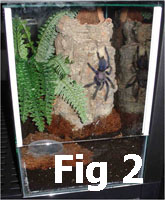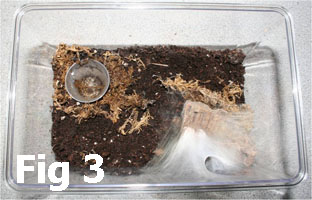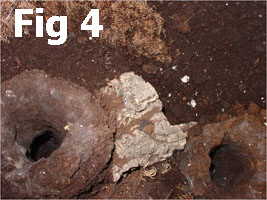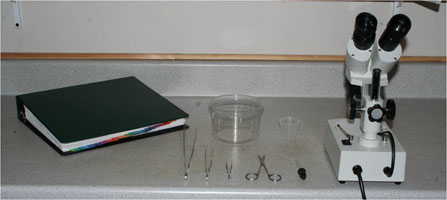Welcome to our new section dedicated to getting you started keeping tarantulas in captivity. Through the years, we have referred the hobbyists we serve to excellent discussion forums such as www.arachnoboards.com to learn more about the maintenance of our beloved animals, but it became clear to us that people want to know how we (Martin and Amanda of Tarantula Canada) care for our tarantulas in our facility.
Hopefully you will find this section helpful. Please keep in mind that this is how WE do things and it is by no means the only way to care for tarantulas. We encourage you to read from different sources and as experience kicks in, you will have your own techniques and tricks. This is the first part of our effort to provide general information about tarantula care. We intend to create more specific guide sheets for specific genera soon.
First, you obviously need to choose an escape proof enclosure. The terrarium can be a simple plastic Rubbermaid container with ventilation holes drilled into the sides. These are perfect for high humidity species, but fully transparent boxes are sometimes hard to find, so they tend to be a little less aesthetic. Another option is to use what we call “kritter keepers”. They consist of clear plastic terrariums with a coloured ventilated top. These are convenient as they are perfectly clear, cheap and very light if you have several on a shelf. The drawback is that ventilation is very high, so humidity is not well kept. They are suitable for semi-arid species, but they can be more difficult to work with for high humidity species. Last, but not least, are the classic glass terrariums. These are heavy and more expensive. They normally come with a screen lid, which we do not recommend. The tarantula will eventually climb and may get its claws (located at the end of the tarsi) caught in the fine mesh. If one decides to use a glass terrarium, we recommend modifying the top part to accommodate a Plexiglas top with sufficient amount of ventilation holes.
When considering how large the enclosure should be, we use what we call the “rule of third”. We determine the size of an enclosure for an adult spider as being three times the size of the legspan of the spider (as a minimum size). One third for the hiding place, another third as an open space clearly defining the spider’s lair and the outside, and the last third partly covered by the water dish.
We are often asked “ If I have a big terrarium, can I separate it and house several tarantulas?” We do not recommend this. Many times people have tried this, and no matter how careful they are in preventing problems, this risk is high that eventually there is one big tarantula and a missing one! You have been warned.
The second step is to choose the substrate on which you will house your animal. We personally like to use “cocofiber” (shredded coconut husk). These bricks can be purchased at your local pet store, but you can save a lot of money by finding the exact same thing in the gardening section of your local Canadian Tire, sold under the name “The Original Cocopeat Block” (this product is easiest to find in the spring and summer months). This substrate retains the humidity well and has the convenience to re-expand if it gets completely dry, unlike regular earth that will shrink and remain in a block once dried up. That being said, organic soil is also welcomed (straight or mixed with cocofiber or peat). After all, tarantulas live on or in earth in the wild, so you cannot go wrong. Just make sure it is pesticide free. We do not recommend straight sand, although mixed with the previous substrates it will work very well for more arid dwelling species. We also do not recommend vermiculite. Aside from not being aesthetic, most tarantulas seem to hate walking on it (they will spend a lot of time climbing). Most important, the dust contained in this product can block the book lungs of your animal and it may die of suffocation (personal experience). It also does not hold well together and obligate burrowers will usually refuse to dig tunnels in it.The amount of substrate you use depends of the behaviour of the species you are keeping (Fig 1). Generally speaking, we consider three types of tarantulas: arboreal, opportunistic, and obligate burrower. For arboreal species, we use a minimum of substrate and place vertical climbing possibilities, like long pieces of cork bark, in the terrarium (Fig 2). We also recommend the use of complete hollow tubes of cork bark. This will provide the best possible hiding place for your arboreal spider. For opportunistic species, we will place pieces of cork bark on the ground and they will usually dig a small depression under it (Fig 3). We normally put enough substrate so that when the spider is climbing on the glass, it can touch the substrate with its hind legs and the lid with its front legs. This limits the available height and the possibility of abdominal injuries if the spider falls. For obligate burrowers, we generally fill the terrarium to at least two thirds full (Fig 4). It is advisable to pre-dig a small burrow that the spider will continue and adapt to its own needs. We also always provide them with a hiding place since it might take some time before they decide to burrow; this will be crucial to the spider’s adaptation.
One very common question is: “Should I bake the substrate before I build the terrarium?” Our answer to this is no. This is not something we have ever done. We believe that by killing all the micro-organisms contained in your substrate, you destroy the balance of its content. The door is then wide open for the first little critter who is now free to colonize your terrarium as desired… and it might be an unwanted one! Welcomed critters will be discussed later.
Once you have the terrarium and the substrate, you simply need to add a hiding place and a water dish. The water dish is not essential, but simply a precaution in case it might get too dry. You will seldom see your spider drinking, but you will be glad you put one when you do. We do not put anything into the dish (sponges, rocks, etc.) and we change the water once a week. We like to add sphagnum moss in the terrarium (not in the water dish, but around it) to help retain more moisture and to add decoration. We use pieces of cork bark for hiding places. You can then add some decoration at will. Be careful with rocks, especially big ones as it is possible a tarantula might completely dig under a big rock and that the tunnel subsequently collapses and kills the tarantula. Terra-cotta pots should be used with caution as well, as the same thing can happen as with the rocks. There is also a hole at the bottom of the pot that the spider might try to crawl through it, get stuck and die (personal experience… again). Most live plants will not do well in terrariums. Not only might the tarantula decide to dig right into the roots, but the light intensity that is safe for the spider will likely be too low for the plant. If you still want to try live plants, make sure the plant will thrive in indirect sunlight and at the same humidity levels as your tarantulas. Also make sure the plants do not have any sharp points, edges, or thorns that will injure your tarantula.
When determining the temperature for a tarantula, a common mistake hobbyists make is to look at the temperature known for the country of origin without knowing the exact micro-habitat the animal comes from. Remember, the average temperature outside may not be the temperature where the tarantulas are making their homes. Take for example a Theraphosa blondi. One will say, an average temperature in Cayenne, French Guyana is 30 Celsius during the day, so this must be the right temperature for T. blondi, right? One could not be further from the truth. First of all, in the shade of a tropical forest, it is never as warm as it is in the city or in direct sunlight; it can cool down several degrees under the forest canopy. Add into the equation a habitat that is on higher elevation, which further cools the temperature. To complete the picture, consider a burrow that goes deep into the ground. What temperature can you expect? Arachnologists in the field have measured temperatures inside T. blondi burrows between 18 and 22 Celsius! In our opinion, many hobbyists keep their tarantulas too warm. Most species, if not all, will do very well at room temperature. On average, we mostly let our spider room go between 24 and 25 Celsius during the day and let it drop between 20 to 22 for the night.
If you believe your terrarium is too cold, first and foremost, remember that tarantulas are not reptiles, and heating units appropriate for reptiles are not always safe for tarantulas. Heated rocks are not good choices for tarantulas, as tarantulas do not bask on warm rocks during the day for heat. Heating pads, the type usually placed under a terrarium, are also not optimal heat sources. When tarantulas are too warm they dig into the ground and the deeper they go, the cooler it gets, so obviously a heating pad under the terrarium provides the reverse effect. It stresses the animals, as it does not know where to go to cool down. If you want to use a heating pad, place it on the side of the terrarium instead, at the end furthest from the burrow. Heating lamps or bulbs can work ok, but be careful to monitor the temperature so that it does not get too warm, and make sure that the tarantula has a hiding place to get out of the light. Do not keep heat lamps turned on 24/7: it is good to give tarantulas a day-night cycle of warms days and cool nights. Humidity is one aspect of tarantula care that sometimes receives too little attention. In fact, we would go as far as saying that its importance is greatly underestimated. Many beloved species of our hobby come from tropical regions, not arid deserts. We are talking 80% to 99% humidity here. Normal humidity in a home is probably around 40% and will easily drop at 20% during our Canadian winters, and if additional humidity is not provided, the tarantulas will surely dehydrate. There are different ways that humidity can be raised. It is usually achieved by a combination of restricted ventilation of the terrarium and adding water to the substrate. We never mist our cages, as the water evaporates quickly and it only raises the humidity for a short period. We prefer to pour water directly into the substrate when necessary. Water poured into the substrate will evaporate much more slowly, and will keep the ambient humidity higher for longer.
Another question we are often asked is “If it is too humid, I won’t I get a mite infestation?” That is the typical ideology of the hobbyist who keeps his or her spider on a bone dry substrate that has been sterilized. The reality is that if you microwave or otherwise sterilize your substrate and then keep the substrate bone dry, you will kill all of the beneficial critters that live in the substrate. If you keep your substrate with a good balance of humidity, then the beneficial critters will survive. The trick is knowing which critters are beneficial, and which are harmful. Small decomposers that live in the substrate, such as scavenging mites (good mites) and spring tails, will help to keep the substrate clean, as they will feed on the leftovers of the tarantula and other organic matter. They also help to protect against parasitic mites (bad mites) as they will eat the eggs of parasitic mites. So how can you tell the difference between the good critters and the bad ones? The most obvious way is to look at them and see where they thrive. If you see them in the substrate, near or in the water dish, or crawling over a bolus left by your tarantulas, these are the good critters. Bad critters are usually parasitic, so look for them clinging to your tarantula, usually near the mouth or leg joints. Also look at their speed. Scavenging mites and spring tails are very active and are constantly on the go. Parasitic mites are usually slow, and will not move unless harassed. Some folks questions us as to whether this system of letting small decomposers thrive in our terrariums works, so consider this. We have over 5000 animals in house at any given time, and we NEVER see parasitic mites… you do the math.
The general maintenance for adult or sub-adult tarantulas consists of a weekly change of water dish, checking the humidity (adding water in the substrate if needed), feeding (a few adult crickets) and picking up any boluses that the spider would have left. Never leave unconsumed live prey with the spider, as they will walk around and stress your animal. The feeding response of a tarantula is extremely quick. If the spider encountered the prey a couple of times and always walks away, chances are it is not hungry.
Spiderling require different care. We house our babies in pill jars of appropriate sizes (Fig 5). It makes the feeding and humidity a lot easier to control. Babies are less resistant to dehydration and extra special care should be taken to monitor the hygrometry of the pill jar. If the substrate starts to become dry or the ambient humidity becomes too low in the enclosure, simply add a few drops of water to the substrate to bring the humidity back up. Aside from that, they are very easy to take care of. You can feed them twice a week with appropriate sized crickets. If you do not have prey items that are small enough, you may pre-kill a bigger prey, as most babies will scavenge for food. You might need to remove left over body parts as a bigger prey often means too much food for the little spider.
Periodically, as tarantula will moult, or “shed its skin”. If you find your spider on its back one day, then it is not dead; it is in the process of moulting. Leave the animal alone and come back in a few hours (or stay and watch) and you will find a pleasant surprise! Before a tarantula moults, it will go into a “pre-moult stage, which can last anywhere from a week or two for small specimens, to a year and more for adults of certain species. The spider will not eat when it is in pre-moult, so monitoring your specimen’s feeding habits is a good way to know when it will moult. Once the tarantula has moulted, it will resume feeding when its exoskeleton has solidified again. After a moult, your tarantula will regenerate any hair, legs, or other external body parts it has lost. Some tarantulas have difficulty moulting. The most common cause of moulting distress is low humidity. Some folks ask “If my spider is about to moult, should I raise the humidity as much as possible?” Our answer is that it is probably pointless. If the terrarium is too dry while the tarantula is in pre-moult, it is probably too late give your specimen the benefit of added humidity during the moult. The important thing, as we said above, is to provide the proper humidity all the time. If your spider has been dehydrating for a long period because it’s terrarium was too arid, it will not change anything that you suddenly raise the humidity when it is about to moult.
We hope that this small general care guide will be useful to the starting hobbyist. We will add more information as we go along.





